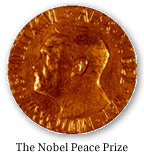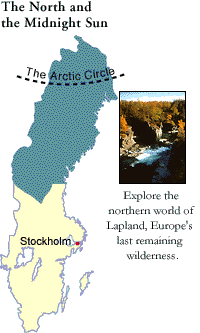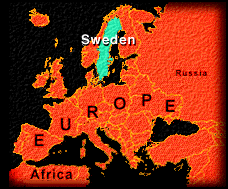
Alfred Nobel
Alfred Nobel was born in Stockholm on October 21, 1833. His father
Immanuel Nobel was an engineer and inventor who built bridges and buildings in Stockholm. In connection with his construction work Immanuel Nobel also experimented with different techniques of blasting rock. Alfred's mother, Andrietta Ahlsell came from a wealthy family. Due to misfortunes in the construction work caused by the loss of some barges of building material, Immanuel Nobel was forced into bankruptcy the same year Alfred Nobel was born. In 1837 Immanuel Nobel left Stockholm and his family to start a new career in Finland and in Russia. To support the family, Andrietta Nobel started a grocery store which provided a modest income. Meanwhile Immanuel Nobel was successful in his new enterprise in St. Petersburg, Russia. He started a mechanical workshop which provided equipment for the Russian army and he also convinced the Tsar and his generals that naval mines could be used to block enemy naval ships from threatening the city. The naval mines designed by Immanuel Nobel were simple devices consisting of submerged wooden casks filled with gun powder. Anchored below the surface of the Gulf of Finland they effectively deterred the British Royal Navy from moving into firing range of St. Petersburg during the Crimean war (1853-1856). Immanuel Nobel was also a pioneer in arms manufacture and in designing steam engines. Successful in his industrial and business ventures, Immanuel Nobel was able, in 1842, to bring his family to St. Petersburg. There, his sons were given a first class education by private teachers. The training included natural sciences, languages and literature. By the age of 17 Alfred Nobel was fluent in Swedish, Russian, French, English and German. His primary interests were in English literature and poetry as well as in chemistry and physics. Alfred's father, who wanted his sons to join his enterprise as engineers, disliked Alfred's interest in poetry and found his son rather introverted. In order to widen Alfred's horizons his father sent him abroad for further training in chemical engineering. During a two year period Alfred Nobel visited Sweden, Germany, France and the United States. In Paris, the city he came to like best, he worked in the private laboratory of Professor T.J. Pelouze, a famous chemist. There he met the young Italian chemist Ascanio Sobrero who, three years earlier, had invented nitroglycerine, a highly explosive liquid. Nitroglycerine was produced by mixing glycerine with sulphuric and nitric acid. It was considered too dangerous to be of any practical use. Although its explosive power greatly exceeded that of gun powder, the liquid would explode in a very unpredictable manner if subjected to heat and pressure. Alfred Nobel became very interested in nitroglycerine and how it could be put to practical use in construction work. He also realized that the safety problems had to be solved and a method had to be developed for the controlled detonation of nitroglycerine. In the United States he visited John Ericsson, the Swedish-American engineer who had developed the screw propeller for ships. In 1852 Alfred Nobel was asked to come back and work in the family enterprise which was booming because of its deliveries to the Russian army. Together with his father he performed experiments to develop nitroglycerine as a commercially and technically useful explosive. As the war ended and conditions changed, Immanuel Nobel was again forced into bankruptcy. Immanuel and two of his sons, Alfred and Emil, left St. Petersburg together and returned to Stockholm. His other two sons, Robert and Ludvig, remained in St. Petersburg. With some difficulties they managed to salvage the family enterprise and then went on to develop the oil industry in the southern part of the Russian empire. They were very successful and became some of the wealthiest persons of their time.
Palme, Olof
1927-86, Swedish political leader, prime minister (1969-76, 1982-1986). Head of the Socialist Social Democratic party, he led Sweden's rejection (1971) of European Community membership and was critical of U.S. policy in Vietnam. In 1982 Palme again became prime minister after his party won the parliamentary elections. Four years later he was assassinated by an unknown gunman.
The building which houses the Anthropology and Sociology department was named after Olof Palme, a graduate of Kenyon College and former prime minister of Sweden.
Olof Palme (1927-1986), was born in Sweden on January 30, 1927. He served in the Swedish army in World War II and began his higher education in Sweden. At Kenyon, Palme was an excellent student, earning all As in his major subjects, economics and political science, and graduating with the Class of 1948. He was sufficiently proficient in French and German to serve as a tutor for his fellow students. He was also a member of Kenyon's first varsity soccer squad.
Palme spent the three months following his graduation on a tour of the United States, embarking with only $300 in his pocket. He later said that what he heard and saw on that trip influenced his political and social ideals.
Upon his return to Sweden, Palme studied law and then became personal secretary to Swedish Prime Minister Tage Erlander, beginning a long career in his country's government. He was elected to the Riksdag, Sweden's parliament in 1958. Palme became minister of communication in 1965 and minister of education in 1967. He won his first term as prime minister in 1968, serving until 1976; he was reelected prime minister in 1982 and again in September 1985.
In June 1970, Palme returned to Kenyon to receive an honorary doctor of humane letters degree. He delivered the principal address, entitled "On the Freedom of Men and the Freedom of Nations" on that occasion. It was his only major address during that trip to the United States, which came at a time when he was a controversial figure in this country as a result of his opposition to the war in Vietnam. But the single jarring note on that June day in Gambier was the presence of two bus loads of members of the International Longshoremen's Association, who came to protest Sweden's criticisms of U.S. policy in Southeast Asia.
 Palme's speech, however, turned on the importance of freedom--academic,
personal, political--and responsibility. "Democratic freedom requires
solidarity among the people," he noted. "In order to live and survive
a society must have a comprehensive solidarity, the ability to recognize the
conditions of other people, a feeling of joint responsibility and participation.
Otherwise, sooner or later, society will fall apart into petty, egotistical
interests. There is never `we' and `they.' There is only us."
Palme's speech, however, turned on the importance of freedom--academic,
personal, political--and responsibility. "Democratic freedom requires
solidarity among the people," he noted. "In order to live and survive
a society must have a comprehensive solidarity, the ability to recognize the
conditions of other people, a feeling of joint responsibility and participation.
Otherwise, sooner or later, society will fall apart into petty, egotistical
interests. There is never `we' and `they.' There is only us."
Palme died on Friday, February 18, 1986 in Stockholm at the hands of an assassin.